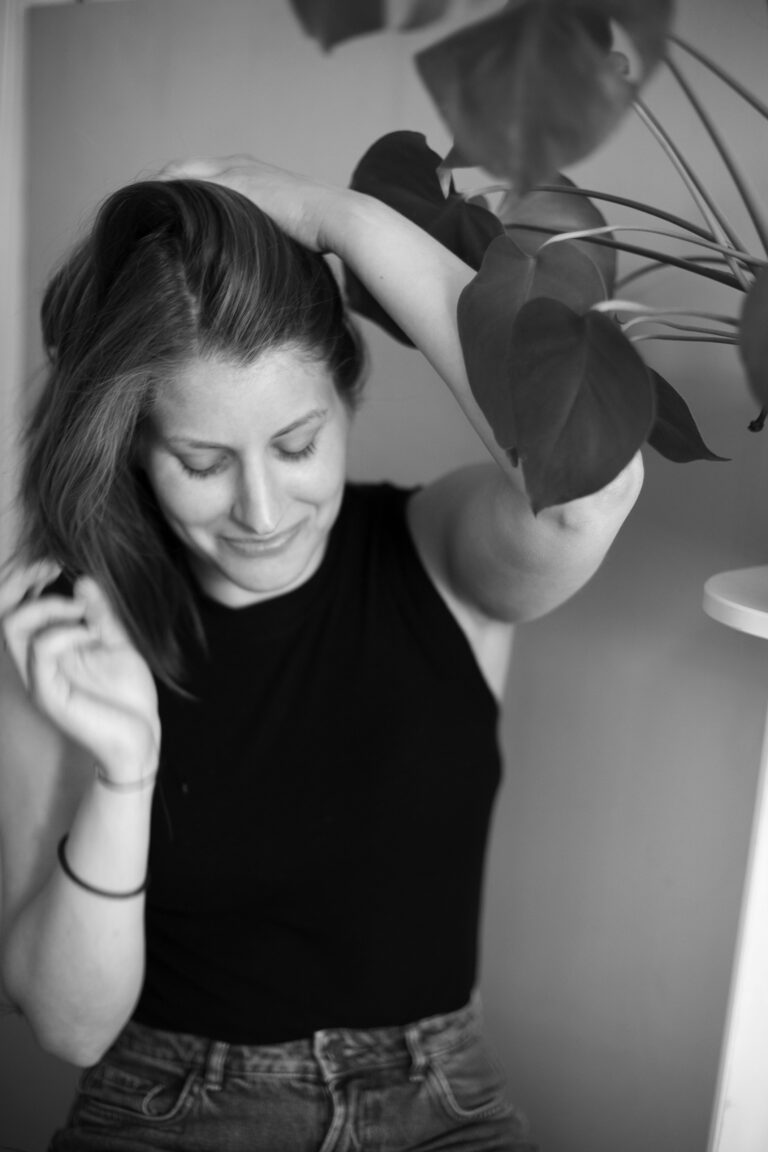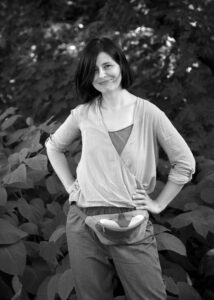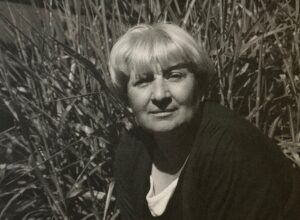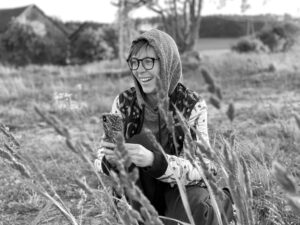Judit Flóra Schuller

– born 1991 – is a visual artist based in Budapest. She obtained her Master of Arts degree from Aalto University School of Arts, Design and Architecture, Helsinki (FI) in 2018, and currently she is a doctoral candidate at the Contemporary Art department at Aalto University. Her main interest is based on the topic of inherited (traumatic) remembrance and its effects on our personal and collective remembrance and identity. She often uses her own family heritage as a starting point, and by doing so she aims to approach a collective reconciliation with the unprocessed narratives of the past through personal, familial elements and micro-histories. In her other works, entitled Light Observations, she engages the question of visual perception through analogue photographic experiments, by focusing on the observation of sunsets, re-created skyscapes and artificial light sources.
By the side of my desk, there is a photocopy of a page from a book1 describing the work of The Atlas Group Archive2, I only wish that I could weep. The work — which is part of the supposedly fictitious archival materials — is about an operator who was sent to the seaside in Beirut to take video footages for the Lebanese army. Instead of fulfilling his task as a security agent, the operator rather focused his camera on the sunset every afternoon and was filming the horizon for four years. In 2016, I pinned the paper to the wall, above my working table and it has been accompanying me since then, through different walls and foreign cities, back to my hometown. I regard it as a reminder, as a poetic note, that leads me back to the core aspects of art that I value the most: the appreciation of ‘beauty’ and the everyday aesthetics, the medium of the archive, and the act of repetition.
Most of my artworks and research takes the family archive as their starting point and inspiration. After inheriting it and taking on the role of the person who takes care of the archive3456789, I found myself faced a chaotic notion that was evoked by the physical and mental burden of heritage. I inevitably felt trapped within it, surrounded by the actual objects, documents, photographs, and the projected memories of the long-deceased family members. In retrospect and a metaphoric manner, I compare my initial approach toward the archive to the silver ring I got from my grandfather as a child. It was a simple, circular form, a loop, a continuous line where the starting point and the ending was the same. To me, it symbolized the uninterrupted state of absence and mourning where the person is kept in the repetitive loop of remembrance.
After working for several years with the archival materials, I have decided to stop wearing the ring and substitute it with a new piece. The act of not wearing my grandfather’s gift felt as a relief from the burden of the family archive. The new ring was not completely closed, it had a gap in between its ends, symbolizing the (archival) state where I continuously intend to arrive, the state of ‘mourned absence’ that releases the descendant from the act of repetitive remembrance.
Through my artistic practice and research, I aim to create ruptures in the repetitive patterns of remembrance in order to create new ones that lead the remembering person toward positive oblivion, where memory is honored and preserved but also leaves space for the living. In 2019, I had the two rings melted together to become part of an artwork. They gained their new, united shape in the form of an organic, circular piece of silver placed on the middle of a granite plate. On the edge of the plate, an engraved quotation by Hanna Arendt runs along following the shape of the circle: ‘What endures, is where one can say — ’Beginning and ending — always the same’1011. The fusion of the two silver rings outlines the continuously transforming balance between the different memorial attitudes and practices: the one that lives in the past and the one that attempts to point toward the future.
My first memories about the family heritage trace back to my early childhood when we used to take long walks with my grandfather and brother. During these walks, we were told stories about the family in a way as fables are narrated. We wandered around Budapest with the revived fragments of the past, on the verge between reality and fiction. I kept on pursuing long and solitary walks as an adult. The most contemplative walks were the ones that led me to the seaside when I was living by the Baltic sea, where the sun usually colors the sky to a light-pink shade as it sets. Unlike collecting and archiving, walking is a repetitive act without any material aim and interest in possessing anything.
As tracing back the threads of the genealogy, one encounters with strong female characters who were the pillars of the family. By their sides, there were sensitive, daydreamer husbands and sons, who were ‘artists’ in the sense of drawing attention to everyday beauty and melancholy that can be traced in their writings, photographs and post-presence they had left in the orally narrated family history. Through their sensitive attitude they had a more dominant impact on me, but at the same time I am grateful to have resilient and strong women as ‘mothers’121314151617.
This statement was written by the artist under the guidance of art historian Róna Kopeczky (2021).
1Charles Merewether, The archive, London, Whitechapel; Cambridge, Mass., MIT Press, 2006.2See: https://www.theatlasgroup1989.org/weep.
3Image: Family archive, Imre Schuller in the family apartment, circa 1941. Courtesy of the artist. The family archive is in-between the state of family heritage and an official archive. My grandfather, Imre Schuller consciously pursued to collect, research, and categorize every material that was related to the family’s history. I regard his archival and hoarder attitude as a counter-act of mourning, as an obsessive and repetitive attempt against forgetting.
4Image: Family archive, back side of a photograph of Miklós Schuller, 1941. Courtesy of the artist. The family archive is in-between the state of family heritage and an official archive. My grandfather, Imre Schuller consciously pursued to collect, research, and categorize every material that was related to the family’s history. I regard his archival and hoarder attitude as a counter-act of mourning, as an obsessive and repetitive attempt against forgetting.
5Image: Family archive, documentation of the family apartment, 2015. Courtesy of the artist. The family archive is in-between the state of family heritage and an official archive. My grandfather, Imre Schuller consciously pursued to collect, research, and categorize every material that was related to the family’s history. I regard his archival and hoarder attitude as a counter-act of mourning, as an obsessive and repetitive attempt against forgetting.
6Image: Judit Flóra Schuller, Inventory, 2015-2018, giclée print mounted on gator foam, 61,5x120 cm. Courtesy of the artist. The family archive is in-between the state of family heritage and an official archive. My grandfather, Imre Schuller consciously pursued to collect, research, and categorize every material that was related to the family’s history. I regard his archival and hoarder attitude as a counter-act of mourning, as an obsessive and repetitive attempt against forgetting.
7Image: Judit Flóra Schuller, Archive Boxes (Towards Nothingness), 2017, giclée print, 27,5x18 cm. Courtesy of the artist. The family archive is in-between the state of family heritage and an official archive. My grandfather, Imre Schuller consciously pursued to collect, research, and categorize every material that was related to the family’s history. I regard his archival and hoarder attitude as a counter-act of mourning, as an obsessive and repetitive attempt against forgetting.
8Image: Judit Flóra Schuller, Archive Boxes (Void), 2017, contact sheet, 24 x 30 cm. Courtesy of the artist. The family archive is in-between the state of family heritage and an official archive. My grandfather, Imre Schuller consciously pursued to collect, research, and categorize every material that was related to the family’s history. I regard his archival and hoarder attitude as a counter-act of mourning, as an obsessive and repetitive attempt against forgetting.
9Image: Judit Flóra Schuller, Archive Boxes (Wall), 2017, giclée print, 70 x 34,5 cm. Courtesy of the artist. The family archive is in-between the state of family heritage and an official archive. My grandfather, Imre Schuller consciously pursued to collect, research, and categorize every material that was related to the family’s history. I regard his archival and hoarder attitude as a counter-act of mourning, as an obsessive and repetitive attempt against forgetting.
10Image: Judit Flóra Schuller, Rings – Notes on Remembrance and Oblivion – Rings, 2019, engraved granite, silver, r46 cm. Courtesy of the artist. Daniel Maier-Katkin & Birgit Maier-Katkin, Love and Reconciliation: The Case of Hannah Arendt and Martin Heidegger, [in:] Harvard Review, 2007 (32), p.47. Retrieved from: http://www.jstor.org/stable/27569287.
11Image: Judit Flóra Schuller, Rings – Notes on Remembrance and Oblivion – Rings, 2019, engraved granite, silver, r46 cm. Courtesy of the artist. Daniel Maier-Katkin & Birgit Maier-Katkin, Love and Reconciliation: The Case of Hannah Arendt and Martin Heidegger, [in:] Harvard Review, 2007 (32), p.47. Retrieved from: http://www.jstor.org/stable/27569287.
12Image: Judit Flóra Schuller, Possibly Maybe, 2012-2013, still from the video, 1'. Courtesy of the artist.
13Image: Judit Flóra Schuller, Mothers 1-2, 2017, giclée print, 48 x 33 cm each. Courtesy of the artist.
14Image: Judit Flóra Schuller, King of the Forest, 2018, still from the video, 2'27''. Courtesy of the artist.
15Image: Judit Flóra Schuller, Chai, 2018, engraved marble, 23 x 28 x 4 cm. Courtesy of the artist.
16Image: Judit Flóra Schuller, Chai, 2018, engraved marble, 23 x 28 x 4 cm. Courtesy of the artist.
17Image: Judit Flóra Schuller, Glockenspiel, 2019, installation, brass bell, iron, handwritten text, 170 x 115 x 70 cm. Courtesy of the artist.
– szül. 1991 – Budapesten élő képzőművész. 2018-ban szerezte MA diplomáját a helsinki Aalto Universtiy School of Arts, Design and Architecture fotográfia karán. Érdeklődése középpontjában az örökölt (traumatikus) emlékek és azoknak a személyes és kollektív emlékezetünkre, valamint identitásunkra gyakorolt hatása áll. Projektjeinek gyakran a családi örökség a kiindulópontja, célja pedig a feldolgozatlan múltbeli narratívákkal való kollektív megbékélés a személyes és családi elemeken, illetve mikrotörténeteken keresztül. A Light Observations című munkái a vizuális érzékelést kutatják analóg fotográfiai kísérletekkel, úgy mint a naplementék megfigyelésével, az ég képeinek újraalkotásával és mesterséges fényforrások használatával.
Az íróasztalom mellett egy könyvből1 kifénymásolt lapon az Atlas Group Archive2 projektjének egy alfejezetét leíró, I only wish that I could weep című szövege áll. A munka – amely része a feltételezhetően fiktív archívumnak – egy ügynökről szól, akit a tengerpartra vezényeltek hogy videófelvételeket készítsen a libanoni hadsereg számára. Ahelyett hogy teljesítette volna a megbízását, az ügynök minden délután a tenger horizontja felé fordította a kameráját és négy éven keresztül a naplementét rögzítette. 2016 óta kísér el különböző helyekre az asztalom fölé kitűzött papír, visszaérkezve szülővárosomba Budapestre. A szöveget egyfajta emlékeztetőnek, költői feljegyzésnek tekintem, ami időről-időre visszavezet a művészet általam leginkább értékelt aspektusaihoz: a szépség és a mindennapi dolgok esztétikájának észrevételéhez, az archívum médiumához és a repetíció folyamatához.
Munkáim jelentős részének kiindulópontja és inspirációja a megörökölt családi archívum. Miután úgy döntöttem hogy gondozni fogom az archívumot3456789, a hagyaték fizikai és mentális terhe egy kaotikus állapotot idézett elő bennem. Bezárva éreztem magam ebben az állapotban, körbevéve a tényleges tárgyak, dokumentumok, fényképek és a rég elhunyt családtagok emlékének jelenlétével. Visszatekintve, az archívum felé irányuló kezdeti kapcsolatomat egy, a nagyapámtól gyerekként kapott ajándék ékszerhez hasonlítom. A gyűrű egy egyszerű, önmagába visszazáródó kör alakú darab volt. Számomra ez a forma a folytonos hiány és gyász állapotát szimbolizálja, amely az örököst bezárja az emlékezet repetitív köreibe.
Miután éveken keresztül foglalkoztam a hagyaték egyes elemeivel, úgy döntöttem hogy nem hordom tovább a nagyapámtól kapott ékszert, és egy új gyűrűt kerestem helyette. Az elhatározást követően megkönnyebbültem az archívum terhétől. Az új gyűrűm nem ért össze, egy rés volt a két vége között. Ez a forma számomra azt az állapotot jeleníti meg, amely felé a művészeti munkáimmal és az aktív emlékezetmunka által igyekszem eljutni. A hiány ebben az állapotban nem egy konstans tényező többé és ezáltal az emlékező személy ki tud törni az önmagát ismétlő emlékezési folyamatból.
Munkáim és a hozzájuk kapcsolódó elméleti kutatás során az a célom, hogy képes legyek változtatni és töréseket létrehozni az emlékezet berögzült mintázataiban. Az újrakonstruált narratívák szöveteiben jöhet létre az a fajta ’pozitív felejtés’, amelynek gyakorlata során az emlékezet ápolásán túl a továbbélés is utat tör magának. 2019-ben a két gyűrűt egybe olvasztattam. Új, együttes formájukban kerültek rá egy kör alakú gránit kőlap közepére, amelynek szélén Hanna Arendt, Martin Heideggernek írt leveléből vett idézet fut végig: „What endures, is where one can say – beginning and ending – always the same.”1112 A két ezüst ékszer egyesülése rávilágít a kétféle emlékezeti attitűd, a múltban megrekedt és a jövő felé mutató emlékezetmunka folytonosan változó egyensúlyára.
A családi hagyatékhoz kapcsolódó legelső emlékeim a nagyapámmal és a bátyámmal közösen megtett, hosszú sétákhoz kötődnek. A városi bolyongások alatt meseszerűen narrált, családi történeteket hallgattunk, amelyek a valóság és a fikció határán mozogva épültek be az emlékezetembe. Később felnőttként, egyedül is folytattam a hosszú sétákat. Sötétedés előtt, a Balti-tenger sétányain megtett utak vittek legközelebb afelé a meditatív és aktívan szemlélődő állapot felé, amelyet az archiválási gyakorlat ellenpontjának tekintek. A gyűjtéssel, felhalmozással és rendszerezéssel ellentétben a sétálás egy olyan repetitív cselekedet, amely nem irányul semmiféle cél vagy materiálás dolog birtoklása felé.
A családfa szálait visszafejtve, számos erős női karaktert találtam, akiknek nagy szerepük volt a család szerkezetének megtartásában. Az oldalukon érzékeny, álmodozó típusú férfiak, férjek és fiak álltak, akik művészek voltak a szó átvitt értelmében. Az utánuk fennmaradt írások, fotók és a családi emlékezetben hagyott, projekción keresztül tovább vitt jelenlétük a mindennapi szépség és melankólia lenyomatait hordozzák. Érzékeny látásmódjukkal nagy hatással voltak rám, ugyanakkor hálás vagyok, hogy erős és kitartó nőket tekinthetek az ’anyáimnak’1314151617.
A statement végleges változata Schuller Judit Flóra és Kopeczky Róna művészettörténész együttműködésében jött létre (2021).
1Charles Merewether, The archive, London, Whitechapel; Cambridge, Mass., MIT Press, 2006.2lásd: https://www.theatlasgroup1989.org/weep.
3kép: Családi archívum, Schuller Imre a családi lakásban, circa 1941. A művész jóvoltából. A családi archívum egy köztes állapotban van, egyszerre hordozza magán egy hivatalos archívum és egy családi hagyaték jellemzőit. Nagyapám, Schuller Imre tudatosan gyűjtött, kutatott és kategorizált minden anyagot, ami valamilyen formában a család történetéhez kapcsolódott. Számomra az ő gyűjtési és archiválási törekvése a megszakított gyászmunka eredménye, egy a felejtés ellenpontjaként űzött megszállott és repetitív folyamat.
4kép: Családi archívum, Schuller Miklós fotójának hátulja, 1941. A művész jóvoltából. A családi archívum egy köztes állapotban van, egyszerre hordozza magán egy hivatalos archívum és egy családi hagyaték jellemzőit. Nagyapám, Schuller Imre tudatosan gyűjtött, kutatott és kategorizált minden anyagot, ami valamilyen formában a család történetéhez kapcsolódott. Számomra az ő gyűjtési és archiválási törekvése a megszakított gyászmunka eredménye, egy a felejtés ellenpontjaként űzött megszállott és repetitív folyamat.
5kép: Családi archívum, a családi lakás dokumentációja, 2015. A művész jóvoltából. A családi archívum egy köztes állapotban van, egyszerre hordozza magán egy hivatalos archívum és egy családi hagyaték jellemzőit. Nagyapám, Schuller Imre tudatosan gyűjtött, kutatott és kategorizált minden anyagot, ami valamilyen formában a család történetéhez kapcsolódott. Számomra az ő gyűjtési és archiválási törekvése a megszakított gyászmunka eredménye, egy a felejtés ellenpontjaként űzött megszállott és repetitív folyamat.
6kép: Schuller Judit Flóra, Leltár, 2015-2018, giclée print gator hablemezre kasírozva, 61,5x120 cm. A művész jóvoltából. A családi archívum egy köztes állapotban van, egyszerre hordozza magán egy hivatalos archívum és egy családi hagyaték jellemzőit. Nagyapám, Schuller Imre tudatosan gyűjtött, kutatott és kategorizált minden anyagot, ami valamilyen formában a család történetéhez kapcsolódott. Számomra az ő gyűjtési és archiválási törekvése a megszakított gyászmunka eredménye, egy a felejtés ellenpontjaként űzött megszállott és repetitív folyamat.
7kép: Schuller Judit Flóra, Archival boxes (Towards Nothingness), 2017, giclée print, 27,5x18 cm. A művész jóvoltából. A családi archívum egy köztes állapotban van, egyszerre hordozza magán egy hivatalos archívum és egy családi hagyaték jellemzőit. Nagyapám, Schuller Imre tudatosan gyűjtött, kutatott és kategorizált minden anyagot, ami valamilyen formában a család történetéhez kapcsolódott. Számomra az ő gyűjtési és archiválási törekvése a megszakított gyászmunka eredménye, egy a felejtés ellenpontjaként űzött megszállott és repetitív folyamat.
8kép: Schuller Judit Flóra, Archival boxes (Void), 2017, kontaktlap, 24 x 30 cm. A művész jóvoltából. A családi archívum egy köztes állapotban van, egyszerre hordozza magán egy hivatalos archívum és egy családi hagyaték jellemzőit. Nagyapám, Schuller Imre tudatosan gyűjtött, kutatott és kategorizált minden anyagot, ami valamilyen formában a család történetéhez kapcsolódott. Számomra az ő gyűjtési és archiválási törekvése a megszakított gyászmunka eredménye, egy a felejtés ellenpontjaként űzött megszállott és repetitív folyamat.
9kép: Schuller Judit Flóra, Archival boxes (Wall), 2017, giclée print, 70 x 34,5 cm. A művész jóvoltából. A családi archívum egy köztes állapotban van, egyszerre hordozza magán egy hivatalos archívum és egy családi hagyaték jellemzőit. Nagyapám, Schuller Imre tudatosan gyűjtött, kutatott és kategorizált minden anyagot, ami valamilyen formában a család történetéhez kapcsolódott. Számomra az ő gyűjtési és archiválási törekvése a megszakított gyászmunka eredménye, egy a felejtés ellenpontjaként űzött megszállott és repetitív folyamat.
10kép: Schuller Judit Flóra, Gyűrűk – Jegyzetek emlékezésről és felejtésről, 2019, vésett gránit, ezüst, r48 cm. A művész jóvoltából. Az számít, amikor elmondhatjuk, – a kezdet és a vég – mindig ugyanaz, Daniel Maier-Katkin, Birgit Maier-Katkin, Love and Reconciliation: The Case of Hannah Arendt and Martin Heidegger, [in:] Harvard Review, 2007, (32). 47 o. Hivatkozás: http://www.jstor.org/stable/27569287.
11kép: Schuller Judit Flóra, Gyűrűk – Jegyzetek emlékezésről és felejtésről, 2019, vésett gránit, ezüst, r48 cm. A művész jóvoltából. Az számít, amikor elmondhatjuk, – a kezdet és a vég – mindig ugyanaz, Daniel Maier-Katkin, Birgit Maier-Katkin, Love and Reconciliation: The Case of Hannah Arendt and Martin Heidegger, [in:] Harvard Review, 2007, (32). 47 o. Hivatkozás: http://www.jstor.org/stable/27569287.
12kép: Schuller Judit Flóra, Possibly Maybe, 2012-2013, állókép a videóból, 1'. A művész jóvoltából.
13kép: Schuller Judit Flóra, Mothers 1.-2., 2017, giclée print, 48 x 33 cm egyenként. A művész jóvoltából.
14kép: Schuller Judit Flóra, King of the Forest, 2018, állókép a videóból, 2'27''. A művész jóvoltából.
15kép: Schuller Judit Flóra, Chai, 2018, vésett márvány, 23 x 28 x 4 cm. A művész jóvoltából.
16kép: Schuller Judit Flóra, Chai, 2018, vésett márvány, 23 x 28 x 4 cm. A művész jóvoltából.
17kép: Schuller Judit Flóra, Glockenspiel, 2019, installáció, sárgaréz harang, vas, kézzel írott szöveg, 170 x 115 x 70 cm. A művész jóvoltából.



